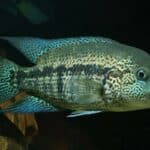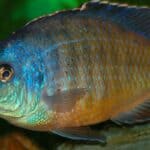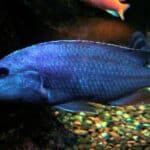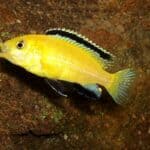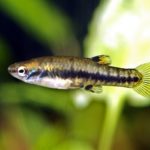If you’re looking for a species of fish that’s guaranteed to liven up your home aquarium, one of the most obvious choices is the Blood Parrot Cichlid.
The Blood Parrot Cichlid, also known as the Parrot Cichlid, is suspected to be the hybridized product of breeding the Gold Severum Cichlid and the Midas Cichlid. With that being said, researchers have yet to confirm this theory officially.
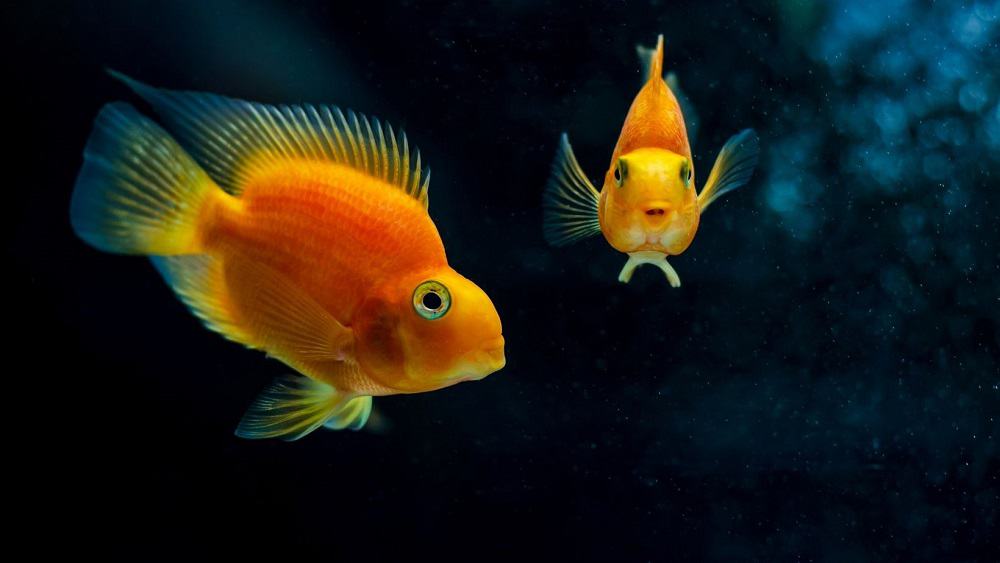
Blood Parrot Cichlids were first bred into existence in 1986, in Taiwan. They are tropical, freshwater fish, although you won’t find them in the wild because they have been bred specifically for aquarium living.
Because of this, and because of the prevalence of deformity in the species (see ‘Common Diseases’), there is a fair amount of controversy amongst the fish-keeping community regarding the ethics of breeding Blood Parrot Cichlids.
If you are considering getting one or several Blood Parrot Cichlids for your aquarium, we recommend reading the following care guide thoroughly. This will help you to understand the needs of this sensitive Cichlid species as well as important factors to consider before committing to your decision.
Care Guide
Tank Size
The size of the tank you’ll need to keep Blood Parrot Cichlids will depend on exactly how many fish you’re planning on keeping in the same aquarium.
For a single Blood Parrot Cichlid, you will need a tank with a capacity of at least 30 gallons. Then, for each additional Blood Parrot Cichlid you introduce to the aquarium, you’ll need to increase your tank size by another 10 gallons.
So, if you wanted to keep 2 Blood Parrot Cichlids, you’d need a 40-gallon tank, 50 gallons for 3 fish, and so on.
Tank Mates
If you want to keep a variety of fish in your aquarium alongside your Blood Parrot Cichlid(s), you’ll need to bear in mind the sizes and temperaments of any other fish you decide to introduce.
Blood Parrot Cichlids aren’t very good at defending themselves against predators or competing for food. Therefore, it’s important not to house them with any large and aggressive fish species. By the same token, you don’t want to introduce any fish that are too small and could be viewed as prey by the Blood Parrot Cichlid.
Compatible tank mates for the Blood Parrot Cichlid include angelfish, tetras of medium size, danios, and catfish. These are mild-mannered and largely non-aggressive fish, making them suitable choices.
Same Species Tanks
Provided that you have a large enough tank, you can keep a colony of Blood Parrot Cichlids together.
It’s worth noting that keeping Blood Parrot Cichlids of the same sex together does not come with the same reproduction risk as most other fish species. This is because the males of the species are, more often than not, infertile.
Therefore, if you’re worried about the potential consequences of keeping male and female fish together, the Blood Parrot Cichlid is definitely one of the safest options.
Water Parameters
The optimal water temperature for a Blood Parrot Cichlid is between 76 and 80 degrees Fahrenheit.
In terms of pH levels, the water should be rated at 6.5 to 7.4. The hardness rating should sit between 6 and 18 dGH.
What to Put in Their Tank
A key piece of information to bear in mind regarding the Blood Parrot Cichlid is the fact that these fish can get very shy and feel the need to conceal themselves from perceived threats.
This means that you will need to set up your Blood Parrot Cichlid tank in a way that gives your fish plenty of hiding spots. You can use various materials and decorations to accomplish this. For instance, you could position some rocks and vegetation at the bottom of the tank.
You could even repurpose items like flower pots.
Blood Parrot Cichlids like to dig, which is why it’s important to line the bottom of the aquarium with sandy substrate.
Remember to leave enough open water at the top of the tank to ensure that your Blood Parrot Cichlid(s) have enough space to move around freely when they feel comfortable to do so.
Common Diseases
One of the major downsides to owning Blood Parrot Cichlids (and one of the primary reasons why the existence of the species is so debated on a moral level) is that they are very prone to ill health.
Ich, also known simply as White Spot Disease, commonly afflicts the Blood Parrot Cichlid. This disease manifests in the form of tiny white spots all over the fish’s body.
Luckily, this particular ailment is easy enough to treat by keeping the water temperature at the highest end of the acceptable range and adding salt to the water at a ratio of 1 teaspoon for every 2 gallons. Alternatively, medicine for this condition is also readily available through pet stores.
Your Blood Parrot Cichlid’s swim bladder may also be prone to issues. The swim bladder is filled with gas and essentially regulates the buoyancy of the fish. Where swim bladder disorder is present, the fish may either sit at the bottom of the tank or float uncontrollably at the top.
Again, however, this disorder is normally easily cured through a 3-day period of fasting followed by a diet of a single skinned pea each day.
Aside from infectious diseases, the genetic makeup of the Blood Parrot Cichlids means that these fish have a number of deformities.
This does not seem to affect them directly in terms of their day-to-day lives, but the deformed shape of the head does prevent them from fully closing their mouths, which some experts believe may hinder their breathing abilities to an extent.
Food & Diet
Because the Blood Parrot Cichlid is, first and foremost, an aquarium fish, its diet is not based on what it would normally eat in the wild.
For this reason, Blood Parrot Cichlids are usually content to eat fish flakes in greater quantities than most fish species. However, to keep your fish as healthy as possible, it’s best to provide as many natural food sources as possible.
This could include live, freeze-dried, or frozen foods. Bloodworms are a particular favorite, while brine shrimp can be fed live to the Blood Parrot Cichlid.
Pro tip: feeding your Blood Parrot Cichlid a diet high in canthaxanthin and b-carotene will help to enhance their vivid coloring.
Lifespan
Most Blood Parrot Cichlids are able to live for at least 10 years in a well-suited aquarium environment, although many can live for as long as 15 years in the absence of serious health conditions.
For a fish, this is a relatively long lifespan, which means that you need to be confident in your ability to care for your Blood Parrot Cichlid(s) for many years.
Appearance
Blood Parrot Cichlids are easy to recognize because of their bright coloring and unique head shape.
The Blood Parrot Cichlid is bright orange with a few white patches in most cases, but Parrot Cichlids have been bred specifically for red or yellow coloring.
Be aware, however, that if you see a Blood Parrot Cichlid of an unusual color, it’s possible that it has been dyed by the breeder for this reason. Unfortunately, this can have a significant impact on the fish’s lifespan.
Naturally, the Blood Parrot Cichlid will have fanned tail fins. If you notice that a Parrot Cichlid has a heart-shaped tail, you should be aware that this is a feature created purposefully by the breeder by cutting the tail fins.
The head of the Blood Parrot Cichlid is distinctly beak-shaped due to genetic deformities. You might notice that the fish is unable to close its mouth all the way because of this. You will also observe that this fish has proportionately large eyes for its head, which is another result of hybridization.
Size
Adult Blood Parrot Cichlids typically grow up to 8 inches in length. This measurement includes the round body and the long tail fins.
Behavior & Temperament
Overall, the behavior and temperament of the Blood Parrot Cichlid is classified as semi-aggressive. This means that they can be aggressive when presented with a threat, although they might also respond with shyness and withdrawal.
Breeding
Generally, it is very difficult to breed Blood Parrot Cichlids together because the males are almost entirely infertile.
In most cases, breeders will only manage to get females to spawn by cross-breeding them with another, non-hybrid Cichlid species.
Gender Differences: Male vs. Female
The only visible difference between male and female Blood Parrot Cichlids is the fact that the males are slightly larger than their female counterparts.
Fun Facts
- The Blood Parrot Cichlid does not have a binomial nomenclature, which is a scientific system used to name animal species.
- Because red is considered a lucky color in China, Blood Parrot Cichlids (especially pure red ones) are considered a fish of positive Feng Shui and may be kept primarily for the purpose of bringing the owner or premises good luck.



